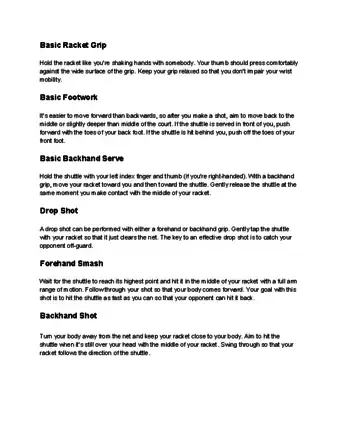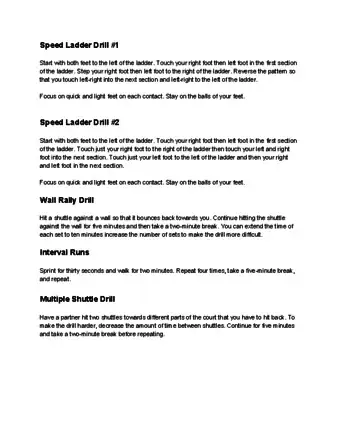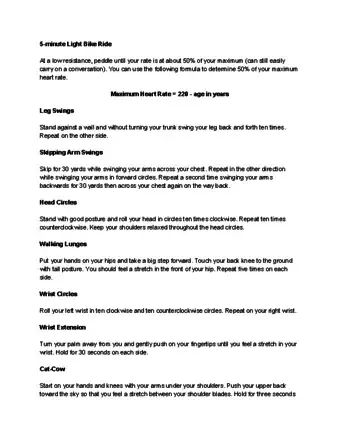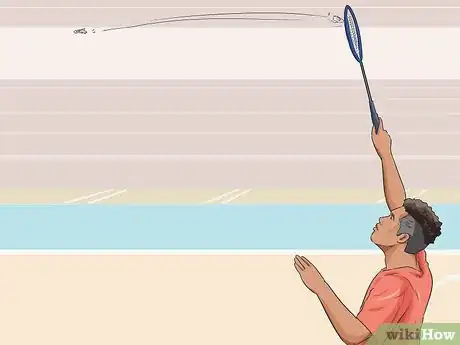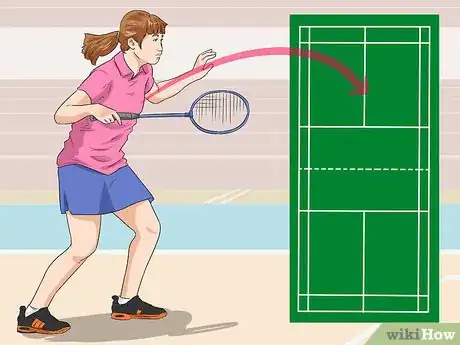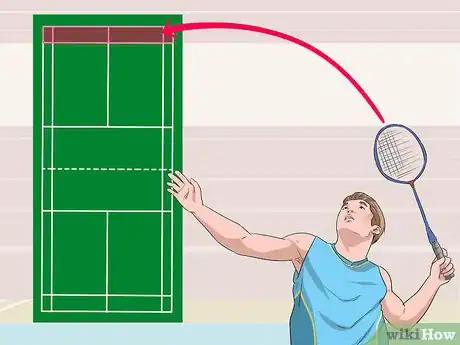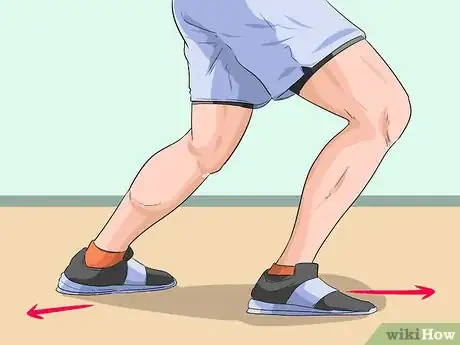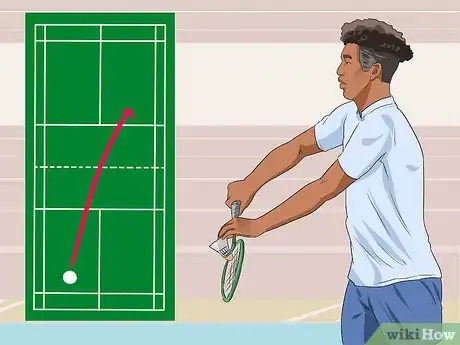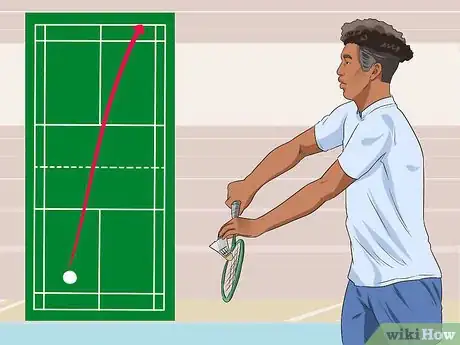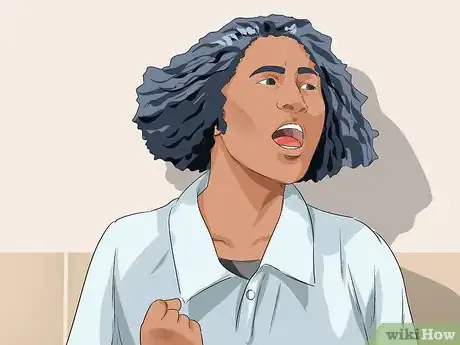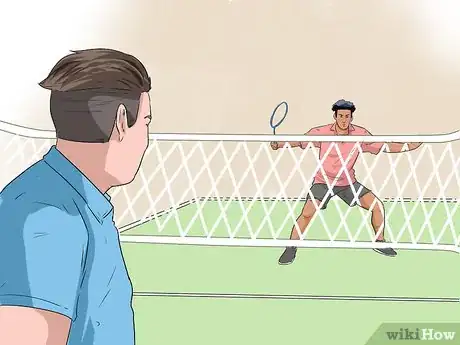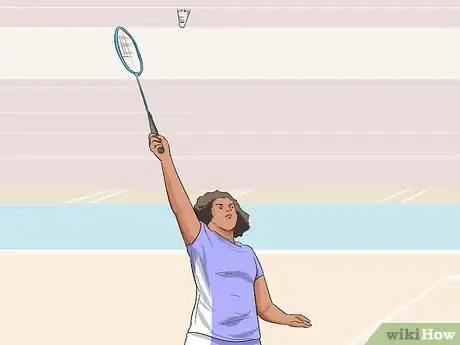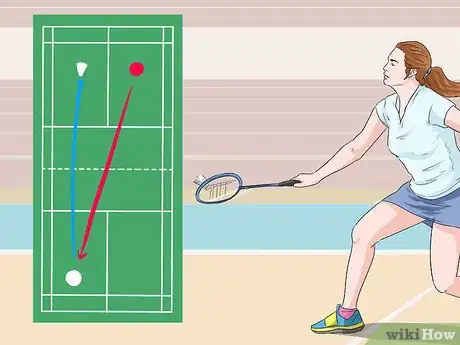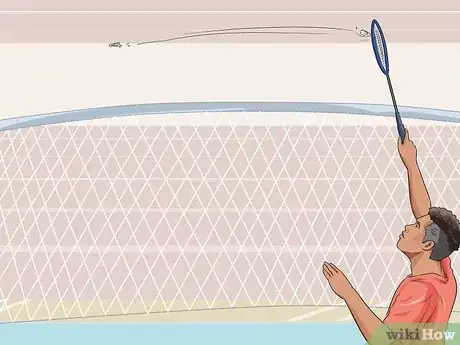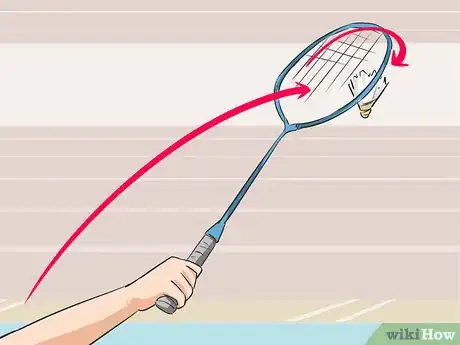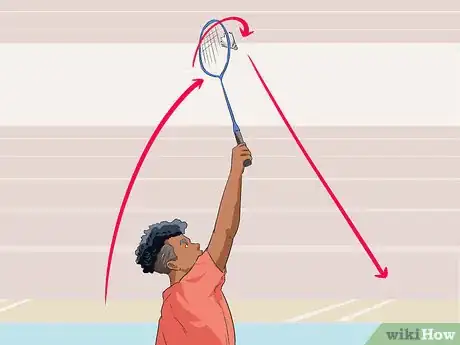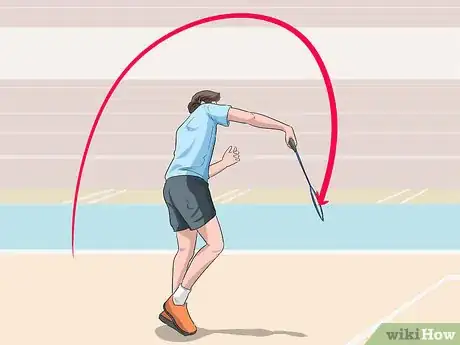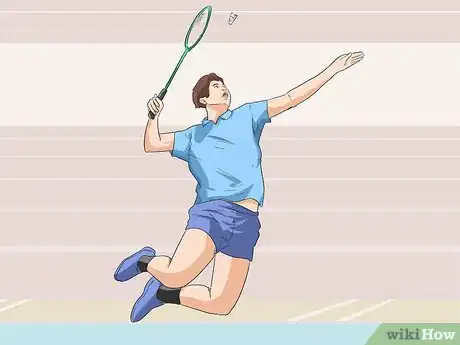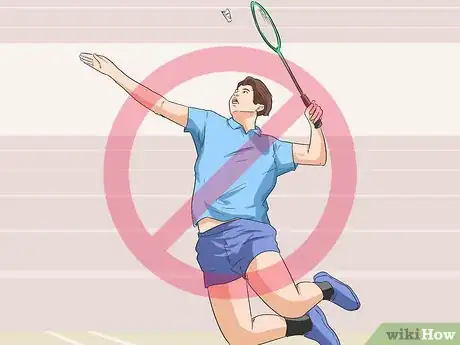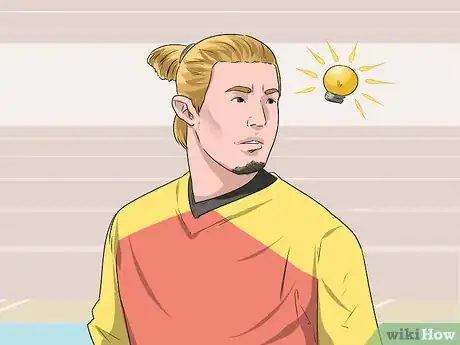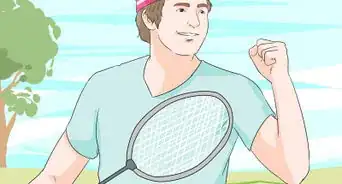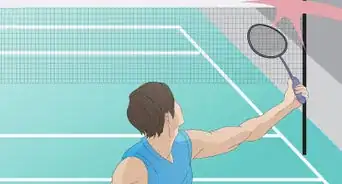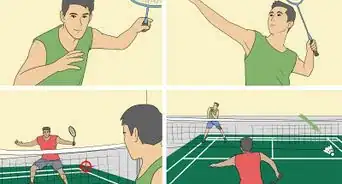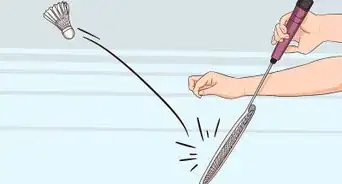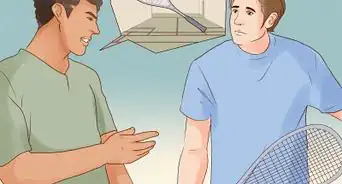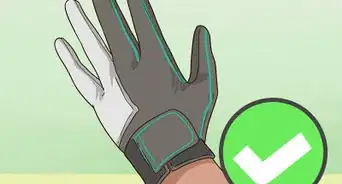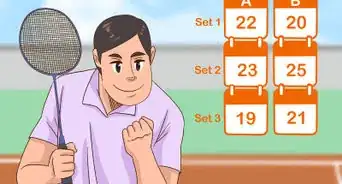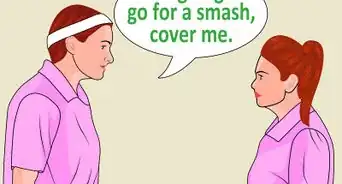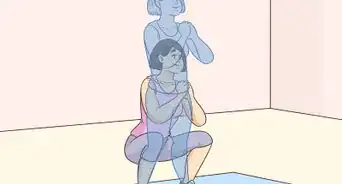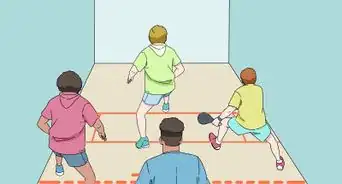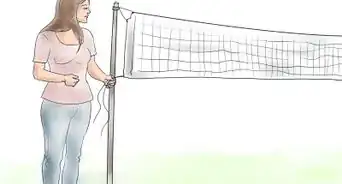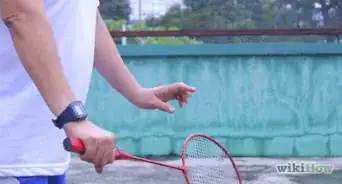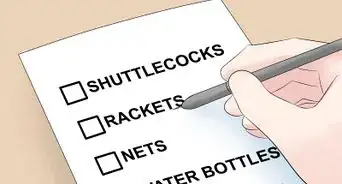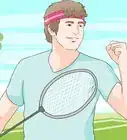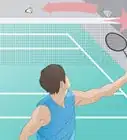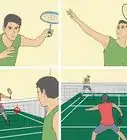wikiHow is a “wiki,” similar to Wikipedia, which means that many of our articles are co-written by multiple authors. To create this article, 150 people, some anonymous, worked to edit and improve it over time.
This article has been viewed 1,303,369 times.
Learn more...
Badminton is a fun sport and a great form of exercise. To be a knockout badminton player, you have to have lightning-fast feet, strong technique, and a cunning sense of strategy. If you already know how to play badminton but want to elevate your game, you will have to find a way to maximize your strengths and exploit your opponent's weaknesses.
Badminton Techniques, Exercises, and Warm up
Steps
Mastering the Basics
-
1Most of the time, try to hit the center of the shuttlecock. You should hit the round rubber centre, or the "sweet spot" of the shuttle every single time. You can practice this technique by looking right at the center of the shuttle when you hit an overhead shot. You can also practice with your hands to try to get a feel for the shuttle.
-
2Hit the shuttle at the top of its arc. To benefit from the speed and height generated by the shuttle, hit it at the top of its arc. This will allow you to shoot a killer overhead and to have more control over the position of the shuttle. Don't wait for the shuttle to come close to you, or it will be losing momentum and height.Advertisement
-
3Always return to the middle of the court after you hit the shuttle. Return to the middle of the back of the court. This will make it more difficult for your opponent to run you around and to hit the shuttle in a place that you can't reach. Standing in the middle of the court while moving your feet and preparing for the next shot will place you in the "position of readiness."
-
4Hit the shuttle toward the back line. Hitting the shuttle toward the back line takes precision and strength, and it will make your opponent have to shuffle backwards and hit the shuttle with a considerable amount of strength to return your shot. If you're not sure where to hit the shuttle next, and the back line is wide open, aim it there. At the beginning, aim the shuttle a bit before the back line so you don't commit a fault if it falls out of bounds behind the back line.
-
5Practice your footwork. Badminton is like squash -- success is all in the footwork. If you're flat-footed on the court, you won't be able to return your shots. Instead, stay on your toes, move your feet up and down as you wait to return a shot, and move your feet back and forth and side to side in tiny motions to position yourself to return the shot. Don't be lazy and reach out your hand too wide to try to return the shuttle -- instead, make tiny movements with your feet until the shuttle is in perfect position. There are some exercises you can do to help you practice:
- Squat jump - Put both hands at your back, then bend your knees as low as you can. Then, jump as high as you can. Do this exercise in 10 reps. This exercise will make your knees and core stronger, so that in the match, you can make a perfect jumping smash.
- Agility ladder - There are variety of exercise you can do with this equipment. It will not only help you to improve your footwork, it also helps you to improve your endurance as well.
- Lunges - Some people hate to do this exercise, but this actually helps you to build muscle on your legs, especially your quad. I would recommend you guys to do 10 reps jump front lunges and also 10 reps side lunges. Make sure you make big lunges when you are doing it. This will help you to take the shuttle easily, especially on the front court. Do not forget to do it in right techniques as well.
- Shadow footwork around the court (with or without shuttle) - Once you have mastered how to take the shuttle in every corner on the court. Get a partner or a coach to help you to point on a corner on the court, then perform the footwork towards the point that has been pointed by him/her.
-
6Practice the short serve. Whether you're playing singles or doubles, the short serve will catch your opponent off guard. He won't be expecting it, and may not be able to run up to return the serve in time. To hit the short serve, you shouldn't just hit the shuttle really lightly, or it will fall on your side of the court. Instead, hit it at a higher contact point and drop it closer to the racket instead of in front of the racket.[1]
-
7Practice the long serve in singles. In singles, hitting a long serve all the way to the back of the service line will throw your opponent off guard. He may be standing in front of the shuttle and can miss it completely, or he may not have enough power to return it. To hit a longer serve, let the shuttle fall in front of you as you swing your racket further back almost to your shoulder level so you generate more momentum before you swing forward and hit the shuttle.[2]
-
8Never give up. Always try to hit the shuttle.
Exploiting Your Opponent's Weaknesses
-
1Understand your opponent's game. When you're playing a new opponent, whether it's at a competition or during a friendly game at a family outing, you should assess your opponent's game even while you're warming up. You should look for a few main things: if your opponent is more of an aggressive or defensive player, if his forehand or backhand is his dominant shot, and any weaknesses, such as slow footwork or weak drop shot returns, that you can exploit.
-
2Make your opponent move around the court. Don't hit all of your shots to the same location of the court of your opponent will be able to predict your next move every time. Instead, mix things up by hitting a drop shot followed by a shot to the baseline, or by moving your opponent from the right to the left side of the court. Moving from the front to the back of the court is particularly tricky unless your opponent has very nimble feet.
-
3Shoot toward your opponent's backhand. Many players are weaker on the backhand side, so try shooting toward your opponent's backhand and see if this makes your opponent return less shots. If so, continue to exploit your opponent's backhand.
- Your backhand is the left side for right-handed players and the right side for left-handed players.
-
4Hit a simple short shot. When you're up at the net, simply hit the shuttle short, just barely over to your opponent's side. This will make your opponent run and will catch him off guard. This is a great technique if your opponent is positioned near the back line. If your opponent knows that you are going to do a short shot, you need to flick the shuttle over the opponent or to another side and if you didn't do this, your opponent will fly the shuttle near the back line.
-
5Change the direction of the shuttle. If your opponent hits the shuttle straight at you, hit the shuttle in a different direction instead of hitting it right back at your opponent, where he will expect it to go. This will work especially well if the shuttle has generated a lot of momentum. If you're quick on your feet, you can change the direction of the shuttle and not give your opponent enough time to react to a fast-moving shuttle.
-
6Hit a drop shot followed by a shot to the back of the court. If you have mastered the drop shot, then use it to make your opponent run all the way to the front of the court. Then return the next shot all the way to the back of the court. Not only will this force your opponent to be quick on his feet, but it will also catch him off guard. This is also a great way to tire your opponent.
- To do a drop shot, hit the shuttle lightly so it just crosses the net.
-
7Make your opponent play your style of game. If you like staying near the net, serve short, hit drop shots, and do whatever you can to make sure that your opponent can't hit the shuttle to the back line. If you're more comfortable at the back line, then serve long and hit speedy long shots so your opponent doesn't have a chance to move you toward the net. Make the opponent lose all control as you play your style of game and maximize your strengths.
Mastering More Advanced Techniques
-
1Slice your net shots. This will make the shuttle spin and fall in an unpredictable direction. To slice your net shot, start the forward motion as you normally would, and then move the racket inward as you slice the racket perpendicular to the center of the birdie. Your opponent will be expecting you to hit the birdie directly forward, while it will actually spin cross court.[3]
-
2Slice your drop shots. To do this, slice the racket, or move it perpendicularly over the center of the shuttle when it's in the air. This will make the shuttle lose much of its momentum and quickly fall on the opponent's side near the net.[4]
-
3Smash the shuttle. Smashing is when you hit the shuttle with all of your strength at the top of its arc. Point your free hand at the shuttle to keep track of its path, and then swing the racket over your head, hitting the center of the birdie and smashing it down into the opponent's court. This is similar to serving in tennis.[5]
- When you're smashing the shuttle, aim is just as important as strength. Don't just blindly hit the shuttle as hard as you can -- you should try to aim it either as far away from your opponent as possible or right at your opponent's body so he will be caught off guard.
-
4Jump before you smash the shuttle. Once you've mastered the standard smash, you can practice jumping up as you smash the shuttle. This will give you even more momentum and will make the shuttle fall into your opponent's court even faster. Just jump up a foot or two, aiming your chest and body in the direction that you want the shuttle to go, and smash it at the center of its arc.
-
5Don't smash the shuttle every time. The smash should be used at a time when the shuttle is high in the air and you have plenty of time to approach -- it should end the point in your favor. If you smash the shuttle at every opportunity, you will tire your arms and will risk smashing it into the net at inopportune moments.
-
6Always plan your next move. A beginning player is just happy when he hits the shuttle over the net. An advanced player understands that a good game of badminton is like a game of chess -- you should always position your shot wisely so that you move your opponent to the exact place where you want him to be so you can hit the following shot. Always plan your next move and always think one step ahead of your opponent.
Community Q&A
-
QuestionHow do I defend against a smash?
 Community AnswerUsually, if your opponent hits a smash directly at you, instinctively you will try to hit it back in the same position, which will most likely make the shuttle hit the net. Instead, quickly step out of the way and hit the shuttle side-on, this will reduce the risk of hitting the net and also defend you against the smash.
Community AnswerUsually, if your opponent hits a smash directly at you, instinctively you will try to hit it back in the same position, which will most likely make the shuttle hit the net. Instead, quickly step out of the way and hit the shuttle side-on, this will reduce the risk of hitting the net and also defend you against the smash. -
QuestionHow can I stop being so nervous when playing in a tournament?
 Community AnswerTake deep breaths, and try not to think about the negative. Don't worry about winning the round, just focus on playing your best. The calmer you are, the better you'll play (and the more it will unnerve your opponent).
Community AnswerTake deep breaths, and try not to think about the negative. Don't worry about winning the round, just focus on playing your best. The calmer you are, the better you'll play (and the more it will unnerve your opponent). -
QuestionI am very lazy and slow, what should I do?
 Julia G.Community AnswerPractice, practice, practice. Start by practicing with parents, relatives and close friends. Then, when you feel like you've got some skill, start going to badminton courses. It doesn't matter if you are slow at first; your speed will improve with proficiency.
Julia G.Community AnswerPractice, practice, practice. Start by practicing with parents, relatives and close friends. Then, when you feel like you've got some skill, start going to badminton courses. It doesn't matter if you are slow at first; your speed will improve with proficiency.
Things You'll Need
- Board shorts
- 2-4 players
- Badminton court
- Badminton net
- Racket
- Shuttlecock(s)
- Good sports shoes
References
- ↑ https://www.masterbadminton.com/badminton-serve.html
- ↑ https://www.masterbadminton.com/badminton-serve.html
- ↑ https://www.masterbadminton.com/badminton-net-shot.html
- ↑ https://www.masterbadminton.com/reverse-slice-drop-shot.html
- ↑ https://www.masterbadminton.com/badminton-smash.html
- ↑ https://www.myactivesg.com/Sports/Badminton/Training-Method/Badminton-for-Beginners/The-different-types-of-badminton-shots-and-when-to-use-them
About This Article
To play badminton better, make sure you're always hitting the round rubber center of the shuffle. Also, try to hit the shuffle when it's at the top of its arc instead of waiting for it to come close to you, which will make your shot faster and more powerful. Whenever you hit the shuffle, immediately run back to the middle of the court so you're ready to hit the shuffle again regardless of where your opponent sends it. You should also always try to hit the shuffle toward the back line on your opponent's court, which will make it harder for them to return. To learn how to master advanced badminton techniques, scroll down!
